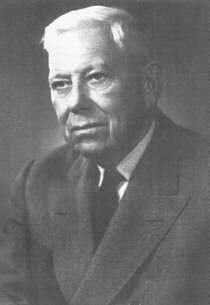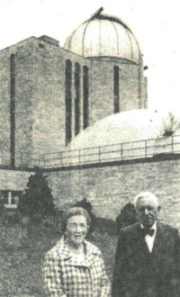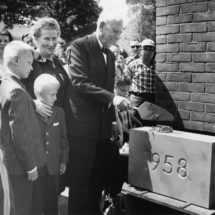George Ritter was born in Vermilion on June 30, 1886.  His father John had come to Vermilion from Meckbach, Hesse Cassel, Germany in 1882, living first with his aunt and uncle, Mr. and Mrs. Lingelbach. John established himself as a tailor, married Louise Hauth and together they had six children.
His father John had come to Vermilion from Meckbach, Hesse Cassel, Germany in 1882, living first with his aunt and uncle, Mr. and Mrs. Lingelbach. John established himself as a tailor, married Louise Hauth and together they had six children.
George attended his first three years of school at the schoolhouse once located in Hanover Square. He graduated from Vermilion High School with the class of 1902.
“The Vermilion News” reported, “As do most of the young people of our town, Mr. Ritter spent many happy boyhood days playing and working along the river.
“As a youth, he learned to string twine and make gill nets and, as old timers around town will tell you, George became the fastest stringer along the lake and could turn our more nets than anyone.” In this way, he earned money for college.
He attended Baldwin University and Cleveland Law School, and although he received his law degree in 1906, he had to wait nearly a year to be admitted to the bar because he had not yet reached the age of 21, according to a newspaper story written by Vermilion’s Sarah Welker.
Ritter married his childhood sweetheart, Mary Fowler of Berlin Heights, in 1911 and began his law practice in Sandusky. The couple moved to Toledo in 1913, where Ritter became a partner in the firm of Kohn, Ritter, Northup and McMahon. In 1917, he organized his own firm with Leland Gardner.
Ritter told Welker that he had originally intended to serve in public office. In fact, he was Toledo city law director in 1928. He gave up public service, though, and became more involved in his law career which “finally resulted in financial success beyond any thought of my youth,” he said.
Ritter had helped reorganize the struggling Willys-Overland Co which was once the second-largest automobile manufacturing plant in America. He became legal counsel to the founder in 1925 and in 1936, he helped guide the company through a change-over that made Willys the first manufacturing plant to be converted to war production.
Although Ritter’s fortune was made, he remained active in his law firm, Ritter, Boesel, Robinson and Marsh.
“I then decided I would try to do something to symbolize my original ambitions to do something for the public,” Ritter told Welker. “I could not see any better way to do it than through fostering religion and education. After a number of years of study, I can still see no better way to do something for my community and my country.”
Thus began the Ritters’ years of philanthropy.
They funded construction of the Ritter Planetarium at the  University of Toledo, the Ritter Library at Baldwin-Wallace College in Berea; a dormitory at Lake Erie College in Painesville (where Mary attended); and the Ohio Legal Center at Ohio State University.
University of Toledo, the Ritter Library at Baldwin-Wallace College in Berea; a dormitory at Lake Erie College in Painesville (where Mary attended); and the Ohio Legal Center at Ohio State University.
Ritter's best known legacy is the building that houses Vermilion’s public library and which is named in tribute to his parents. Ritter grew up during the time Andrew Carnegie was funding construction of public libraries across the country, and it was said George was disappointed that Vermilion wasn’t included.
George served on the board at the Toledo Museum of Art, Toledo Hospital, the YMCA and was a trustee of Baldwin-Wallace College. Mary served as a trustee at Lake Erie College. They donated an organ to the Congregational church in Vermilion and funds for the Fowler Memorial Room at the Berlin Heights Congregational Church.
Ritter was a member of many clubs and organizations and won many honors including from the Ohio Bar Association and Rotary Clubs International. He has been named to the Vermilion High School Hall of Fame.
Although the Ritters lived in Toledo and spent winters in Florida, in the 1950s they still maintained a family home in Vermilion on Main Street (the house is just north of the Main Street Soda Grill) and spent many weekends there during summers.
They travelled abroad and indulged their interest in antique furniture. George was also a golfer and enjoyed hunting and fishing, both in Florida and as a member of the Castalia Trout Club.
The couple had no children. George died on June 23, 1979, just days before he would have celebrated his 93rd birthday and his 68th wedding anniversary. Mary died the next month at the age of 93.
In his will, Ritter left money for construction of an addition to the library building, which was completed in 1983 and named in memory of his sister, Allie.
His will also directed that a trust fund be established for the library. Money from the trust enabled the library to purchase membership in the CLEVNET library consortium in 1985, and it continues to be a source of funding today.
George also left money in his will to provide a full, four-year scholarship at Baldwin-Wallace College for a young man graduating from either Ottawa Hills High School in Toldeo or George’s own alma mater, Vermilion High School.
 The town of Vermilion will hear from George Ritter yet again.
The town of Vermilion will hear from George Ritter yet again.
There is a sealed box placed in the southwest corner of the library building behind the cornerstone. In the box is a letter from Ritter with instructions that it not be opened for 100 years. In 2058, residents may open the letter for a final message from the library’s great benefactor.
